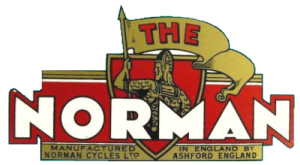Norman Motorcycles, Kent
Norman Cycles was a British bicycle, autocycle, moped, and motorcycle
manufacturer based in Ashford, Kent.
The Norman Cycles Club is based at Willesborough Windmill, in Willesborough, part of Ashford. The Norman Museum is located in the Windmill's barn, where they have some
mopeds and bicycles on display.
-
Founded in the 1920s by the Norman brothers, Charles and Fred, on their return from France at the end of the WW1 they started making pedal cycles.
-
1935 They commenced motorcycle production.
-
1935 Moved to a new factory in Beaver Road, Ashford.
Roamer were motorcycles produced after the end of the Second
World War, by Norman.
The name, like Rambler, was
used for models exported to Australia after the end of the war. The only
difference was the tank transfer.
Norman motorcycles were produced in Ashford in Kent from 1939 to
1962, by brothers
Charles and Fred Norman. (Charles had created
the Kent Plating and Enameling Company before World War 1).
-
1939 The firm was already well known in the field of bicycle manufacture,
and other enterprises, when they entered the powered market that year.
They started out with two models: an autocycle with rigid forks, known
as the Motobyke; and a 122cc Lightweight. Both were powered
by Villiers engines.
-
1940 The De Luxe model with Webb girder forks joined the range, together with a lower-geared Carrier model and a 98cc version of the Lightweight. That year Norman
also made autocycles for Rudge.
-
Production then stopped until the end of World War II.
-
1946 Manufacture recommenced with a range all fitted with Villiers
engines. These comprised the 98cc Autocycle and the 122cc Motorcycle.
-
1949 These became the model C with 99cc Villiers
2F, and model B1 with Villiers
10D engines. Then came the B2, with the 197cc Villiers
6E engine. Both B models were listed in standard and de luxe
versions.
-
1951 The model D arrived, powered by the 99cc Villiers 1F unit.
-
1953 Rear suspension was added to create the B1S and the B2S.
The B1 became the model E and a competition model, the 197cc
B2C, joined the range.
-
1954 Eight trials machines were entered in the Scottish Six Day event.
The models E and B2 were dropped by the end of the year.
-
1955 The D and B2C were gone by the end of the year and the
B1S changed its engine to the 147cc Villiers
30C and a twin. The TS model appeared using the British Anzani
engine. In came Armstrong leading-link forks, which were to become standard.
-
1956 The B2S was listed with the 197cc Villiers
9E engine, and the 8E also remained for the next couple of
years. The B2C/S also appeared. New for that year was the 48cc Nippy
moped, with a Sachs engine and Continental
design.
-
1957 Also listed was the B1S with an alternative of the 148cc Villiers 31C. Rear enclosure was adopted for most models. At about this time Norman bought the German Achilles tooling. Both Villiers and Sachs engines were used in their Nippy mopeds of that year.
1958 The twin changed its engine to create the B3.
1959 The B3 Sports joined the range. Another version of the moped
appeared, with a 50cc Villiers
3K engine, plus the Achilles-based Lido model, with a styled enclosure for
the power unit. Over the following few years those models were improved.
1961 The twins were modified to become B4 models, and the competition
machines changed to the B4C Trials and the B4C Scrambles.
The mopeds were followed by improved versions. Charles and Fred Norman
both retired, so the firm was taken over by Raleigh
Industries and moved to Smethwick.
1962 Only the twins survived into that year, plus the mopeds based on Raleigh
models. Production ceased that year and the Norman name came to an end.
Source: Graces Guide
If you have further information or a query related to this page, please contact us


